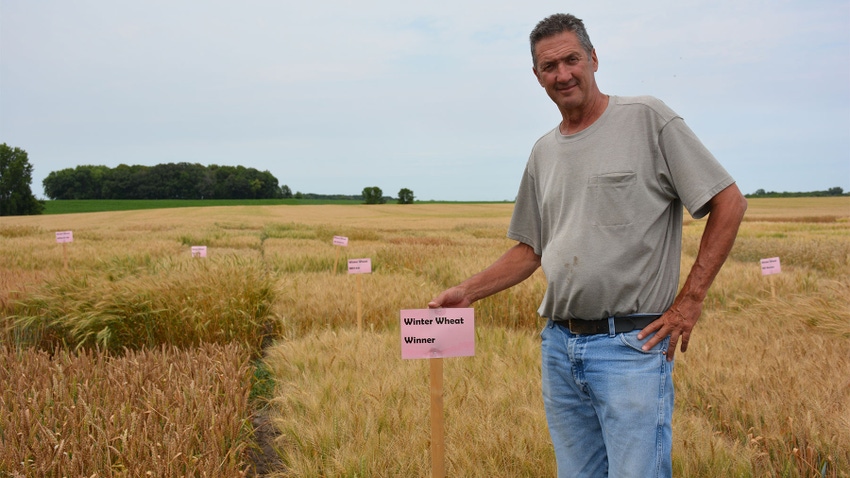
Ron Pomije doesn’t have to wait for publication of test plot results to see which small grains work best on his farm. Nor does he have to question if the published plot results will translate well to his specific farm. He merely walks out to the fields of his LeCenter, Minn.-area farm to see for himself.
For the past dozen years, Pomije and Ruth Hoefs have cooperated with the University of Minnesota for small grain trials on their farm, and they know which varieties work well on their soil, and were raised under the same conditions as their cash grain production.
“We’ve always had small grains, and I was approached to have the plots here because we do a really good job on our small grains in our rotation,” Pomije says after a test plot field day on his farm.
This front-row seat to small grains production allows Pomije to adapt. “We grew AC Emerson winter wheat, and now we switched to Winner [from South Dakota State University], just for the fact of the standability and the protein is a little bit higher than the AC Emerson — so we’ve switched according to what they’ve got out here.”
This year the 2 acres of small grains plots, which also showcase spring wheat, oats, barley, winter rye and winter triticale, are located east of his homeplace, and a golden field of Winner winter wheat surrounds the test plot area. In addition to the small grains, the diversified farm also raises sweet corn, soybeans and corn; and Hoefs raises about 30 ewes and 10 brood cows.
Showing grains environment
Pomije isn’t the only one who benefits from the U-M plots on his farm.
“We know there’s this concept called genotype-by-environment interaction: Basically, not every variety does the same thing in every single location, or every single year at the same location,” says Jochum Wiersma, U-M Extension professor and small grains specialist based at the Northwest Research and Outreach Center at Crookston, Minn. “We’re trying to sample as many ‘environments’ for growers to get the best chances of picking varieties that work in their area and their geographic niche. So, because there’s wheat acres across and there is barley and oat acres across all the state, we want to sample as many environments as possible.”
Historically, southern Minnesota crop research plots have been reserved for the U-M Research and Outreach centers at Waseca and Lamberton, “and now we have spots in between,” Wiersma says. Wiersma sees the Pomije trials supplementing the work at Waseca, but there are also test plots at Rochester, Becker (under irrigation), Benson, Fergus Falls, Crookston and another seven locations spreading to the Canadian border.
In addition to Wiersma, Jim Anderson, U-M professor and spring wheat breeder; and Kevin Smith, U-M professor and oat and barley breeder, oversee the small grains plots across the state. As with any trials, there are winners and losers. “Some varieties work across the state; some varieties really should only stay in part of the state,” Wiersma says, “and some of them should not be in Minnesota.”
Small grains challenge
Pomije has an agronomy degree from Mankato Technical College and worked as an agronomist for a cooperative for a number of years before turning to full-time farming. That background has aided his operation, in addition to the lessons learned from the U-M test plots.
“Wheat is the biggest challenge to manage,” he says, comparing the other crops in the rotation. “It’s a lot of weather control. You’ve got to treat it like any other crop. You just can’t plant it and expect it to do a good job for you. … This year, we sprayed with a fungicide early, and we didn’t have to come back because it’s been so dry.”
Putting an emphasis on management, Pomije says, “The heat we had during heading that might hurt us on our yield, but we’ll find out here within the next week. … When fusarium head blight hits, it happens to flowering of the small grain, and with that heat you can pollinate within two or three days. So, you’ve got to be right there to catch it. We’ve got a really short window, a couple-day window. If you line up the helicopter like we do, you got to have them notified before — because it hits you fast.”
Though not growing test plots for his other crops, Pomije is not averse to trying different corn and soybean offerings. He has a nephew and a brother who sell seed for Golden Harvest and NK, and among the three of them, they pick the hybrids and varieties that will work best. “We have really high fertility on the farm,” Pomije says. “Our pH is all over 6.5, our phosphorus level numbers are 25 parts per million and our K is 220 per million, so we keep it up pretty good.”
About the Author(s)
You May Also Like






